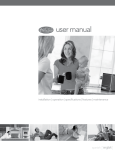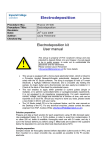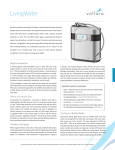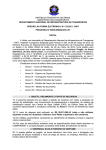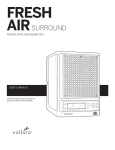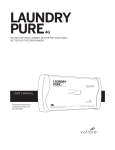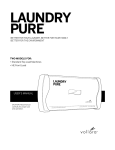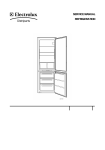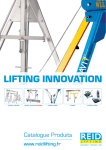Download EcoQuest Fresh Air Troubleshooting guide
Transcript
Troubleshooting Guide for Fresh Air 120FA / 1.5! www.ecoquestparts.com ! Page 1 Troubleshooting and Repair Guide Alpine / EcoQuest Fresh Air 120FA / 1.5 by Carl Powell III Introduction The Fresh Air 120FA or 1.5 model (EcoQuest seems to have named ALL their systems “Fresh Air”, so you have to refer to them by the model number) has been a work horse of an air purifier for a decade or more. The latest models from Vollara, Inc. (who eventually bought most of EcoQuest International) use the same technologies, just with a little bit of a twist. However, the 120FA and 1.5 models have been long ago discontinued and Vollara no longer supports these models with parts and repairs. But don’t worry, we still do! In fact, we’ve gone out of the way to help our customers keep up and running with their old dependable purifiers! This guide is one example of how we help our customers with their systems. We also answer questions and source our own parts when they are no longer available. How does it work? Here you’ll find a down-to-earth, plain english description of what your purifier does. Inside this machine, you’ll find four or five different methods (depending on the model) of purification to make your home or office air cleaner. They are: 1) Ozone Production from the Ozone Plate or Purifier Plate ! Ozone, when released into the air, combines with odors, gasses and chemicals in the air reducing them to odorless and harmless materials. The ozone combination causes a chemical reaction that results in reducing them to oxygen and water. A little ozone is a good thing, just be careful not to use too much. It can be an irritant to some people (some much more than others). A good rule of thumb is to set the unit so that you can smell just a little when you walk into the room, but don’t notice it after a few minutes. If you can smell it all the time, it may be set too high. Use the square footage guide on the LCD panel as a starting point and adjust as needed. 2) RF Ionization from the energized antenna ! The RF ionizer uses a radio-like signal that alternates to create a signal that gives all the material floating in the air to take on either a positive or negative charge as it works. When a piece of dust or other particle with a positive charge comes close to one with a negative charge, they are attracted together. When enough get together, they have enough weight to fall from the air to the floor where it can be vacuumed and removed. 3) Needlepoint Ionization ! Depending on the model, you may also have a type of ionization that emanates from a small needlepoint located in the front of the unit. This performs a similar function to the RF Ionizer, but uses direct ionization instead. Troubleshooting Guide for Fresh Air 120FA / 1.5! www.ecoquestparts.com ! Page 2 4) UV Light ! The UV Lamp in this unit is exposed to all the air that is drawn through the unit. This kills any bacteria that may be present in the air at the time. Although these units are not typical air “filters” a certain amount of filtering does take place and when small bacteria get through, they are killed, decreasing odors and possibly sickness in the process. 5) Target Plate or RCI Plate ! The target plate in this unit has undergone several evolutionary changes over the years. Originally, it was a very dense “metal screen” treated with chemicals. But this proved to reduce the air flow inside the units too much*. So, a second type was introduced with about 1/3 of the metal screen removed from the frame. Still not optimal, a smaller screen type was introduced that was basically the 2/3 of the original size, but made of about the same material. NOTE: If you still have one of the above type target plates, you need to replace it as it is no longer working and may harm your machine. Finally, a screen with a metal “holey” center was introduced. This allows for more air flow and a larger area for addition of the chemical. The process that happens when the UV Light hits this chemical is a purifying process that the company calls “Syn-Air-G.” It is similar to the processes used in the Space Shuttle and the Space Station. *One of the side effects of the reduced air flow was corrosion on the connectors inside the unit. This shows up as a green or white powdery substance on electronic connections. More on this later. The combination of the types of purification happening inside and outside your unit make it an excellent choice for purifying the air in your home or office. It is safe, simple, and effective. Here is a list of advantages the company lists for this model in the owners manual: Eliminates smoke, odors, and tobacco smoke. Sanitize feature kills mold, mildew, and bacteria in unoccupied spaces. UVC light helps kill airborne germs as they pass through the unit. Removes odors from your home, office, car, boat, RV, etc. Improves the quality of air indoors Helps control additional dust and dander when an optional EcoHelp filter is properly installed. Customizable to your environment using either the included remote or the controls on the front of the unit. • IntelliAir™ Technology alerts you when normal maintenance needs to be performed or service is required. • • • • • • • Troubleshooting Guide for Fresh Air 120FA / 1.5! www.ecoquestparts.com ! Page 3 Care and feeding of your Fresh Air Purifier As can be attested to by my customers, this unit will last for YEARS. Some have had them for as many 10 years and they’re still working. But this will not happen if you do not maintain your unit. It needs REGULAR care to last that long. Here’s how you keep in top working condition: Clean Monthly If your unit is running properly, it should remind you to “Perform Cleaning” about every 30 days. Whether it tells you or not, you should do this monthly. Here’s how you do it: Turn the unit off and unplug it for all cleaning procedures. 1) Vacuum the back lint screen. This screen is to keep out the larger dust that could clog your purifier. Keep it clean to allow the system to work properly. When it appears to be worn out, or not working well (the carbon doesn’t always keep working), replace it. If you have a carbon back filter, do not wash it. Just vacuum it off. 2) Vacuum the inside. Just vacuum what you can get to, looking for the larger dust deposit. Clean where you can using a crevice tool if you have one. 3) Clean the purifier plate. Pull the plate out toward you and clean it with a small brush like a toothbrush and a mixture of 1/2 ammonia and 1/2 water. Clean it well and let it dry completely before replacing it. Usually a towel dry and maybe some time with a hair dryer will get it dry enough to replace it. 4) Clean the RCI Target Plate. Since this plate has a chemical on it, you only want to remove the extra dust on it, not the entire coating on the metal plate. If you notice that the material is starting to come off the metal plate, it may be time to replace it. You can also turn the target plate over each month as the metal is coated on both sides. 5) Vacuum the front and rear grill openings. Again, just looking to keep the dust off of as many surfaces as possible. A damp cloth can also be used to wipe the unit down to keep it dust free. Do the above every month for best results. Perform As Needed Sometimes the fan blade will get very dusty and that reduces its efficiency. You can remove the four screws that hold the front grille in place and remove it. Then just wipe the blades down with a damp cloth to remove the excess dust. Troubleshooting Guide for Fresh Air 120FA / 1.5! www.ecoquestparts.com ! Page 4 Your unit has expendable supplies that NEED to be replaced regularly If you run your unit occasionally, or only when needed: 1) The Ozone/Purifier Plate should be replaced at least every two years. 2) The Target/RCI Plate Should be replaced at least every two years. 3) The UV Lamp should be replaced at least every two years*. If you run pretty much all the time: 1) The Ozone/Purifier Plate should be replaced at least every year. 2) The Target/RCI Plate Should be replaced at least every year. 3) The UV Lamp should be replaced at least every year*. You may not notice the difference, but these three parts are fairly inexpensive and help keep your unit in tip-top condition and at its best efficiency level. *It is a good idea to replace the starter unit for the bulb when the bulb is replaced. A bad starter could blow a good bulb. Troubleshooting your unit We’ll start by giving you the troubleshooting guide that is included with the manual. It will answer some of your questions and many of the most common problems. Indicators of Operation When the unit is on the LCD display will show the fan setting, purifier setting, and square footage. If the unit is in sanitizer mode, it will display SANITIZE and the hours and minutes remaining. Troubleshooting - What to look for first. 1. I have plugged in the unit, turned “on” the main power switch, pressed the ON button on the remote (or the unit) and nothing happens...what's wrong? • Make sure the power cord is inserted completely into the receptacle on the back of the unit. • Make sure the electrical outlet is capable of providing power to the unit. • Check the lint screen located at the back of the machine to ensure that the safety switch activator clip depresses the safety switch. • Check to see if the proper fuse is installed and that it is operational. 2. The fan is operating but the Purifier Plate is not working...what's wrong? • The unit will display a REPLACE PLATE message. Check the purifier plate for serviceability. If it is cracked or broken, the purifier plate will require replacement. Ensure maintenance procedures required for the purifier plate have been performed according to the "Maintenance" section of this Owner's Manual. Order new plates from www.EcoQuestParts.com. Troubleshooting Guide for Fresh Air 120FA / 1.5! www.ecoquestparts.com ! Page 5 • Electrical stainless steel contacts are not contacting the screen portion of the purifier plate. Unplug and inspect the unit for any loose connections. • Do not attempt to disassemble the unit, this will void the warranty of the product. (Note from Ecoquestparts: Your warranty was out long ago. This does not apply to you. ) 3. The Purifier Plate is making a noise, has a burning smell, and/or appears to arc or spark. What is the problem? • The purifier plate is most likely cracked. The unit will display a REPLACE PLATE message. Refer to the answers for question # 2, as it would apply to this question also. 4. The UV lamp is not functioning / I’m getting a “Replace Lamp” message. • Check lamp for proper installation. • Replace UV Lamp. PLEASE NOTE: If unit has been recently transported check lamp for proper installation, remove Lamp and reinstall. 5. What are the most typical application problems? • Symptom: A belief that the proper equipment is placed in the environment and the equipment appears unsuccessful. Problem: Lack of air movement, improper placement of the unit. • Symptom: Strong odors still remain within the environment after placement. Problem: Purifier setting is too low or improper placement of the unit. • Symptom: A strong odor of ozone is present within the environment. Problem: Too much ozone accumulation within the environment as a result of improper purifier control setting, and / or lack of air movement. • Symptom: Visual haze of smoke and / or particulate remain within the environment. Problem: Lack of ionization and / or air movement. 6. How can I tell if the UV lamp is functioning? • The UV lamp will produce a glow that is visible through the front grill under low light conditions CAUTION: Do not look directly at the glowing lamp. Troubleshooting Guide for Fresh Air 120FA / 1.5! www.ecoquestparts.com ! Page 6 EcoQuestParts - Additional Troubleshooting and Repair Instructions In addition to the items listed above, we have found the following to be of help to our customers: 1) The LCD screen says “Replace Plate”, but I have already replaced the Ozone Plate with a new one. ! Problem: Either you have poor contact with the plate, or the connectors to the plate are corroded. This sometimes happens when there is poor circulation inside the unit due to using one of the older style target plates. ! Solution: First clean the contacts where the plate screen comes in contact with the plate cage. You can use some fine sandpaper, an eraser, or an emery board to do this. Second, check for green or white corrosion near or inside the connectors to the plate cage. If you find any, clean them well with some baking soda and water. If this does not solve the problem, you can order parts from www.ecoquestparts.com to replace the connectors. 2) The unit is on, but I don’t smell the “clean” smell (ozone). ! Problem: This means that there is no voltage getting to the purifier/ozone plate. ! Solution: See #1 just above to make sure all the connections are good. If this does not solve the problem, then your unit may be experiencing problems with the transformer on the main circuit board. This could be a sign that it is near its end of life. 3) The UV Lamp does not come on. ! Problem: Either the lamp is bad (not likely), the socket is dirty, or the ballast system for the UV Lamp is finally beginning to give up. ! Solution: First, rock the bulb back and forth in the socket. This will “clean” a good contact place on the connectors inside the brackets. Next, try using another starter to see if it is working properly. If these do not fix the problem then you have discovered a problem that we have found that is apparently going to plague more and more customers. (See “Lamp doesn’t Work” below) 4) The fan is moving slowly, or not at all. ! Problem: The motor may have gone bad. Or it is very dirty. ! Solution: The motor can be replaced pretty easily. It is held in place by two bolts and is connected with two push on spade lug type connectors. It is available on our website at www.ecoquestparts.com. 5) The “Lamp doesn’t work” problem When this unit was invented and manufactured, UV Lamps were powered by what is referred to as a “starter/ballast” system. It consists of a florescent starter and a ballast transformer. The transformer serves to reduce the voltage to the bulb and the starter builds up a “shock” to “start” the bulb working. More and more, we’re seeing units that just flash when you put a new bulb in. Or they will glow on each end and not come on completely. WARNING: DO NOT LOOK AT THESE UV BULBS DIRECTLY WHEN TESTING ONE, THEY CAN DAMAGE YOUR EYES. Troubleshooting Guide for Fresh Air 120FA / 1.5! www.ecoquestparts.com ! Page 7 I have done extensive testing on bulbs and units and have found this to be an increasing problem. The reason for this appears to be that most all UV Lamps are now manufactured for electronic ballasts not for the old transformer ballast systems. I have personally tested well over 100 bulbs from multiple shipments and suppliers to find that most of them (although a few do) will not work in a ballast system and DO work in the electronic system. My conclusion The age of these units, combined with the latest manufacturing methods used has caused an incompatibility between the bulbs we have to sell and the equipment. Either the equipment or ballast is “just worn out enough” to not work, or the bulbs just don’t work with them. I continue to search for a solution for this issue. For now, I have plans to provide an upgrade kit for your unit that allows you to switch over to an electronic ballast and avoid having to put your unit down. If all goes will, this will happen by September 2014. So, if it’s after that date, check www.ecoquestparts.com for that upgrade kit. Troubleshooting Guide for Fresh Air 120FA / 1.5! www.ecoquestparts.com ! Page 8 How to maintain and repair your Fresh Air Purifier To access the inside of your 120FA purifier, remove the one or two screws on the back cover and remove it. From the manual, here is a diagram showing how to remove the screws and the back filter. Next, remove the purifier plate and the target plate. Troubleshooting Guide for Fresh Air 120FA / 1.5! www.ecoquestparts.com ! Page 9 Once you have removed the plate cage, you have also exposed the back of the fan motor and can remove the screws and connections to it. Remove the front grille to pull the motor out the front to replace it. If you replace the motor, you can use the same fan blade if it is not damaged. A new one is not expensive, but the old one can be washed in the dishwasher or hand washed and reused. It can be very difficult to remove the old fan blade. It is attached by what is called a “friction” fitting. In other words, it’s just pushed on and is a tight fit. I find it is sometimes easier to have someone hold the motor and another person hold the fan blade and have both pull very hard to get it off. Troubleshooting Guide for Fresh Air 120FA / 1.5! www.ecoquestparts.com ! Page 10 When you replace the fan blade, you will have to position it just right so that it does not touch on the back or on the front grill. Adjust it a little at a time and put the grille back on to try it out until you get it the right distance from front and the back and it no longer touches anything while turning. Other parts There are a few other parts that may need replacing or can go bad. Unfortunately, the front LCD panel and main circuit board are no longer available. If either of these go bad, you may have to trade your unit in on a new one. (We offer trades, just contact us at our website: www.ecoquestparts.com.) Antenna The antenna is located atop a ceramic insulator near the center of the cabinet. The antenna will sometimes get corroded and possibly rust. If it is just dirty, you can clean it during your monthly cleanings. If it gets bad, it’s best to replace it. A clean antenna will work better. They are also available on our website with a new plastic insulator. Other items like power cords, rubber feet, screw sets, etc. can also be replaced as needed. We carry a good selection of miscellaneous parts and accessories for your purifier. If you have other questions, you can contact us at sales@ecoquestparts.com.










